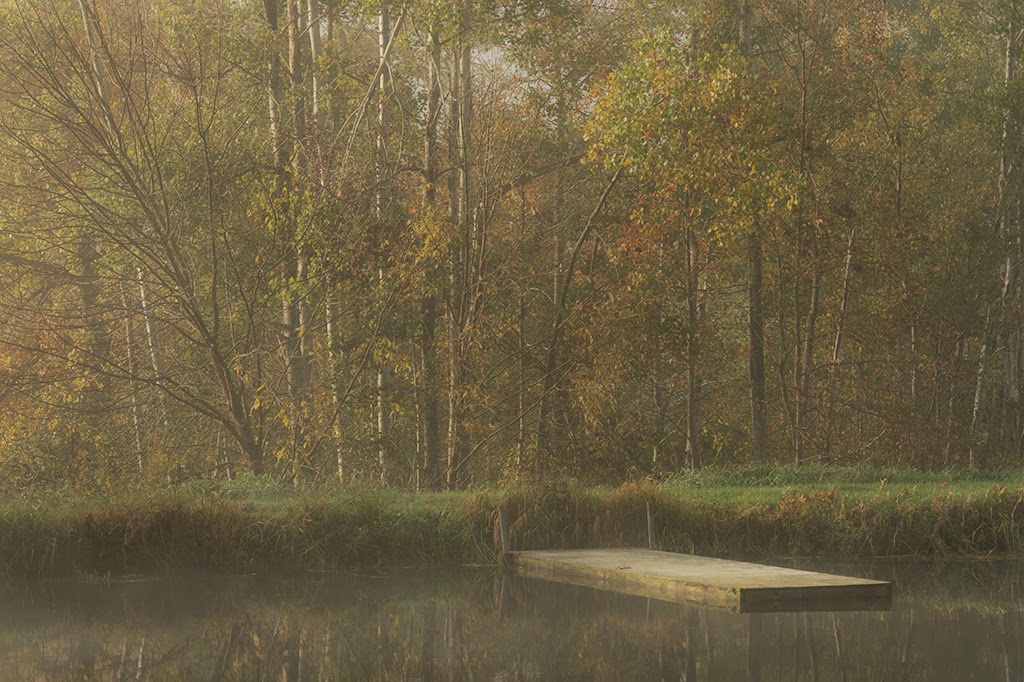 |
| Aperture f~16 Shutter 1/50 sec ISO 100 Focal Length 125 Lens 70-200 Nikon D4 |
About this image:
This scene in Hampton, New Brunswick, Canada evoked a sense of nostalgia in me. On a morning shoot, I found this small pond, only large enough to be a swimming hole, in a meadow in early morning light as a gentle mist was beginning to lift. It harkened the end of the summer season. The colors of the vegetation, the stillness of the water and the moodiness the mist brought to the scene enhanced the feeling I had of the past. I felt a sense of visual poetry in this scene. As a young teen, I had a swimming hole my boyfriend and I used to visit in an old quarry, that is now fenced off and impossible to access. This scene, when I saw it put a smile on my face thinking that yes, children somewhere on the planet still enjoy an Old Swimming Hole! I made several compositions with focus on the soft light striking the floating platform but liked this one best, it was the first shot I made of the scene. I processed the image minimally in Photoshop and removed a distracting red float in the water at the end of the platform. When composing the image I paid particular attention to the balance between the lower third of the image and the trees with the beautiful sidelight. I was also paying attention to exactly where in the frame the floating platform was located in the lower right of the frame.
When preparing to write this blog I "Googled" "The Old Swimming Hole" and found the poem by James Whitcomb Riley about The Old Swimming Hole written in 1883. Some things never change!
It made me think about how our images can align with the heart of a poet, both evoking a feeling or emotion in the viewer or reader.
The Old Swimmin' Hole
Oh! the old swimmin'-hole! whare the crick so still and deep
Looked like a baby-river that was laying half asleep,
And the gurgle of the worter round the drift jest below
Sounded like the laugh of something we onc't ust to know
Before we could remember anything but the eyes
Of the angels lookin' out as we left Paradise;
But the merry days of youth is beyond our controle,
And it's hard to part ferever with the old swimmin'-hole.
Oh! the old swimmin'-hole! In the happy days of yore,
When I ust to lean above it on the old sickamore,
Oh! it showed me a face in its warm sunny tide
That gazed back at me so gay and glorified,
It made me love myself, as I leaped to caress
My shadder smilin' up at me with sich tenderness.
But them days is past and gone, and old Time's tuck his toll
From the old man come back to the old swimmin'-hole.
Oh! the old swimmin'-hole! In the long, lazy days
When the humdrum of school made so many run-a-ways,
How plesant was the jurney down the old dusty lane,
Whare the tracks of our bare feet was all printed so plane
You could tell by the dent of the heel and the sole
They was lots o' fun on hands at the old swimmin'-hole.
But the lost joys is past! Let your tears in sorrow roll
Like the rain that ust to dapple up the old swimmin'-hole.
Thare the bullrushes growed, and the cattails so tall,
And the sunshine and shadder fell over it all;
And it mottled the worter with amber and gold
Tel the glad lilies rocked in the ripples that rolled;
And the snake-feeder's four gauzy wings fluttered by
Like the ghost of a daisy dropped out of the sky,
Or a wownded apple-blossom in the breeze's controle
As it cut acrost some orchard to'rds the old swimmin'-hole.
Oh! the old swimmin'-hole! When I last saw the place,
The scenes was all changed, like the change in my face;
The bridge of the railroad now crosses the spot
Whare the old divin'-log lays sunk and fergot.
And I stray down the banks whare the trees ust to be—
But never again will theyr shade shelter me!
And I wish in my sorrow I could strip to the soul,
And dive off in my grave like the old swimmin'-hole.







